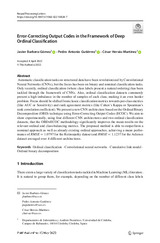Error-Correcting Output Codes in the Framework of Deep Ordinal Classification
Autor
Barbero-Gómez, Javier
Gutiérrez, Pedro Antonio
Hervás-Martínez, César
Editor
SpringerFecha
2022Materia
Ordinal classificationConvolutional neural networks
Cumulative link model
Ordinal binary decomposition
METS:
Mostrar el registro METSPREMIS:
Mostrar el registro PREMISMetadatos
Mostrar el registro completo del ítemResumen
Automatic classification tasks on structured data have been revolutionized by Convolutional Neural Networks (CNNs), but the focus has been on binary and nominal classification tasks. Only recently, ordinal classification (where class labels present a natural ordering) has been tackled through the framework of CNNs. Also, ordinal classification datasets commonly present a high imbalance in the number of samples of each class, making it an even harder problem. Focus should be shifted from classic classification metrics towards per-class metrics (like AUC or Sensitivity) and rank agreement metrics (like Cohen’s Kappa or Spearman’s rank correlation coefficient). We present a new CNN architecture based on the Ordinal Binary Decomposition (OBD) technique using Error-Correcting Output Codes (ECOC). We aim to show experimentally, using four different CNN architectures and two ordinal classification datasets, that the OBD+ECOC methodology significantly improves the mean results on the relevant ordinal and class-balancing metrics. The proposed method is able to outperform a nominal approach as well as already existing ordinal approaches, achieving a mean performance of RMSE=1.0797 for the Retinopathy dataset and RMSE=1.1237 for the Adience dataset averaged over 4 different architectures.

